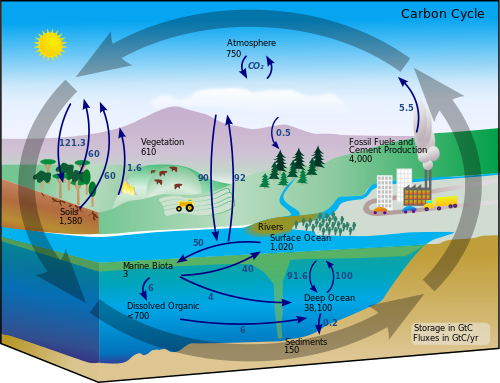Final Project: Lesson
Introducing Students to the Carbon Cycle - This lesson will most likely take two class periods, with the focus on an introduction to the carbon cycle on day 1 (steps 1 - 3) and the carbon/climate/culture connection on day 2 (steps 4 - 6).
Goals: Students will become familiar with carbon, the carbon cycle, and the impact of increased carbon dioxide in our atmosphere on Earth's climate.
- Students will learn about the carbon cycle.
- Students will learn of the role of carbon dioxide as a greenhouse gas.
- Students will learn about human influences on the carbon cycle.
- Students will find out how climate change is affecting people and their environments.
Rationale: During the "Cycles" theme we have previously focused on the water cycle. After taking this course, I realize that there are many resources out there that can be used to introduce the carbon cycle to elementary-aged students. While the main focus will be on how carbon naturally cycles through our ecosystem, it is important to take a look at human influence on this cycle, and how this is related to climate change. Greenhouse gases such as carbon dioxide are a key factor in climate change.
Lesson: Introduce students to the carbon cycle using the following plan -
1. Read introduction to the carbon cycle as a group. Use projector in order to do so.
2. Students will individually play the The Carbon Cycle game
3. Using what they learned from the game, students will create a drawing/poster of the carbon cycle.
4. Read background information provided by Teachers' Domain then view: Global Warming: Carbon Dioxide and the Greenhouse Effect - Have partners choose one of the following discussion questions (from TD) to address:
- Why does the image of the scientist in the video segment fade after carbon dioxide has been turned on? How does this explain the greenhouse effect?
- Draw a diagram that explains how radiant energy from the Sun heats Earth's atmosphere. Show how heat is absorbed and reradiated by both Earth and the greenhouse gases in the atmosphere.
- What personal actions do you think might contribute to the amount of carbon dioxide entering the atmosphere, either by increasing it or decreasing it?
- How long does it take for carbon dioxide to spread throughout Earth's atmosphere? How long does it take to be absorbed into the oceans?
- Under what circumstances do you think carbon dioxide in Earth's atmosphere becomes harmful? Explain.
5. Assign each group (students work in learning teams) a region to research in terms of climate change issues. Have groups identify and report key issues to class. Resource: Global Climate Change Impacts in the United States
6. View: Inuit Observations of Climate Change from Teachers' Domain
Extensions:
Scientists have discovered that these microbes are active much deeper into winter then previously thought, producing carbon dioxide as they break down organisms. Students may be suprised to learn that soil microbes contribute 1/2 of the CO2 produced in Arctic. Snow protects and warms the permafrost below, allowing microbial activity deep into winter, releasing not only CO2, but nutrients beneficial to taller, shrub like plants. These in turn, collect snow, warming permafrost even more efficiently, with increased microbial activity. This is an example of a Positive feedback loop.
Lesson Resources:
VisionLearning.com - The Carbon Cycle - What Goes Around, Comes Around
Windows to the Universe - The Carbon Cycle
Teachers' Domain - Global Warming: Carbon Dioxide and the Greenhouse Effect
Global Climate Change Impacts in the United States
Teachers' Domain - Inuit Observations of Climate Change
United States Global Change Research Program
Additional Resource: The world's most current data for atmospheric CO2 is from measurements at the Mauna Loa Observatory in Hawaii.

No comments:
Post a Comment